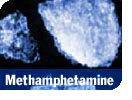LSD | Rohypnol | GHB | Ketamine | Steroids | Tobacco | Alcohol
Drug Information for Methamphetamine

Methamphetamine (sometimes referred to as methylamphetamine or desoxyephedrine) is a psychostimulant drug used primarily for recreational purposes (under the street-name crystal meth), but is sometimes prescribed for Attention-deficit hyperactivity disorder and narcolepsy under the brand name Desoxyn. It causes euphoria and excitement by acting directly on the brain's reward mechanisms, thus making it highly addictive.
Methamphetamine rapidly enters the brain and causes a cascading release of norepinephrine and dopamine (and to a lesser extent, serotonin). Users may become obsessed or perform repetitive tasks such as cleaning, hand-washing or assembling and disassembling objects. Withdrawal is characterized by increased sleeping and eating, and depression-like symptoms, often accompanied by anxiety and drug-craving.
History
Methamphetamine was first synthesized from ephedrine in Japan in 1893 by chemist Nagayoshi Nagai. In 1919, crystallized methamphetamine was synthesized by Akira Ogata via reduction of ephedrine using red phosphorus and iodine. The related compound amphetamine was first synthesized in Germany in 1887 by Lazar Edeleanu.
One of the earliest uses of amphetamine occurred during World War II when the German military dispensed the stimulant under the trade name Pervitin to troops. The drug was widely distributed across rank and division, from elite forces to tank crews and aircraft personnel. Chocolates dosed with methamphetamine were known as Fliegerschokolade ("flyer's chocolate") when given to pilots, or Panzerschokolade ("tanker's chocolate") when distributed to tank crews.
From 1942 until his death in 1945, Adolf Hitler was given daily intravenous injections of methamphetamine as a treatment for depression and fatigue. It is possible that the Parkinson-like symptons which Hitler increasingly developed from 1940 onwards were related to his use of this drug.
Addiction
Methamphetamine is highly addictive, particularly when injected or smoked. While not life-threatening, withdrawal is often intense and, as with all addictions, relapse is common. To combat relapse, many recovering addicts attend 12 Step meetings, such as Crystal Meth Anonymous.
In an article about his son's addiction to methamphetamine, a California writer who has also experimented with the drug put it this way:
Former users have noted that they feel stupid or dull when they quit using methamphetamine. This is because the brain is adapting a need for methamphetamine to think faster, or at what seems to be a higher level. Individuals with ADHD may be at higher risk for addiction to methamphetamine, because the drug increases the user's ability to focus and reduces impulsivity. Because of its abuse potential, meth is not generally prescribed for ADHD unless other stimulants, such as methylphenidate (Ritalin®), dextroamphetamine (Dexedrine®) or mixed amphetamines (Adderall®) have failed.
With long-term use, abstinence often leads to slow thinking and depression, which in turn requires that the addict use more meth to 'fix' it. A chronic pattern of such behavior is known colloquially as "The Vampire Life."
Serious drug addiction correlates with poor hygiene and general self-care, and even minor health problems can lead to serious complications when left untreated. Striking health problems popularly associated with methamphetamine addiction, such as severe tooth decay or massive skin infections, are caused by unsterilized needles and a lack of hygiene. Even long-term use does not generally result in outward symptoms, but may lead to hypertension, damage to heart valves, and increased risk of strokes.





